Is Exercise The Solution To Your Back, Neck & Joint Pain?
What’s the BEST advice we can give you if you want to stay or get active when you have back, neck or joint pain? That we have to LOOK at YOU! There is no “typical” patient. Everyone is unique – in how a body is built and works, and what’s done with it. Typical concerns and 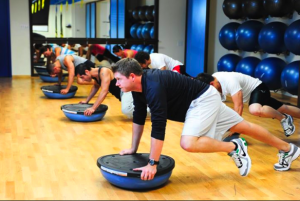 questions are of course, what is MY problem? Then, can it be helped with Chiropractic care in our Minneapolis/St. Paul Chiropractic Clinic? The concerns we hear are often tied to being able to work, support families, and…continue or begin to participate in a recreational or athletic activity. You know…the FUN stuff! People want to DO stuff. They want to exercise, de-stress, get fit, or continue to stay fit. It might be the pursuit of running a 5K or marathon, keep weight off or get it off, play hockey or volleyball,… or just keep dancing. We understand that! To do your FUN stuff though, you have to do and know a few things:
questions are of course, what is MY problem? Then, can it be helped with Chiropractic care in our Minneapolis/St. Paul Chiropractic Clinic? The concerns we hear are often tied to being able to work, support families, and…continue or begin to participate in a recreational or athletic activity. You know…the FUN stuff! People want to DO stuff. They want to exercise, de-stress, get fit, or continue to stay fit. It might be the pursuit of running a 5K or marathon, keep weight off or get it off, play hockey or volleyball,… or just keep dancing. We understand that! To do your FUN stuff though, you have to do and know a few things:
- Heal up first
- Your “biomechanics” have to be addressed
- Support your structure
- Manage your muscles
A structural (bones, joints, muscles, etc.) injury or “breakdown” means pain, inflammation and joint motion typically has to be restored – at least to a pre-injury status, and of course if this “conservative” (non-surgical) approach is the appropriate course to follow. After an assessment of the exact problem, joint adjustments/mobilizations will be necessary along with appropriate therapies to relieve the “acute” situation. Staying mobile is important, but not overdoing. This only creates set-backs, or worsened injuries. “Go-easy” is the mantra. Listen to what the body is saying. No Pain-No Gain is out!
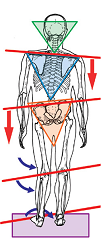 Next, its vitally important to know what caused you to break down or injure in the first place. So often, even an acute, traumatic injury had a back drop of “biomechanical ” faults associated with it, resulting in WHY that area got injured, or WHY it got hurt as much as it did. A person’s biomechanics are uniquely represented by way of their “structural fingerprint” – the unique set of imbalances, incorrectly working joints and de-conditioned (not weak) muscles that virtually everyone develops – and from a very early age! The importance of knowing this can’t be stressed enough. Most people think “fitness” is the first step, but its not. The true first step is biomechanics. How many people start exercising, get injured, and then stop. Knowing and addressing your biomechanics will insure that you can begin or continue exercising without being injured early in your program, and then exercise/rehab can be tailored specifically to you.
Next, its vitally important to know what caused you to break down or injure in the first place. So often, even an acute, traumatic injury had a back drop of “biomechanical ” faults associated with it, resulting in WHY that area got injured, or WHY it got hurt as much as it did. A person’s biomechanics are uniquely represented by way of their “structural fingerprint” – the unique set of imbalances, incorrectly working joints and de-conditioned (not weak) muscles that virtually everyone develops – and from a very early age! The importance of knowing this can’t be stressed enough. Most people think “fitness” is the first step, but its not. The true first step is biomechanics. How many people start exercising, get injured, and then stop. Knowing and addressing your biomechanics will insure that you can begin or continue exercising without being injured early in your program, and then exercise/rehab can be tailored specifically to you.
Supporting the human structure begins with the feet. Virtually everyone has some type of mechanical problem with their feet by the age of 40. 80% by the age of 20. With age and the continued effects of weight and gravity, these just continue to progress. Foot and heel pain along with plantar fasciitis, dropped arches, bunions and hammer toes are just a few of the more common problems. Since the feet are the “critical” foundation for the rest of the 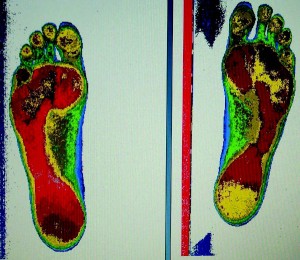 structural system, any problem here has a domino-like effect all the way up, exerting increased stresses on the knees, hips, back, etc. Good quality footwear in combination with biomechanically oriented (the whole body structure) custom orthotics insures better shock absorption throughout the feet and body, along with improved balance and improved body weight distribution. These are all important aspects of preventing injury, and especially with exercise.
structural system, any problem here has a domino-like effect all the way up, exerting increased stresses on the knees, hips, back, etc. Good quality footwear in combination with biomechanically oriented (the whole body structure) custom orthotics insures better shock absorption throughout the feet and body, along with improved balance and improved body weight distribution. These are all important aspects of preventing injury, and especially with exercise.
Muscles need to be free of “trigger points” (knotted areas within the muscles) to function with efficiency and reduced chance of injury. These de-conditioned sites require re-training, loosening, improved flexibility and resilience, or the muscles will continue to work too hard, under perform and run the risk of injury. Muscle management protocols need to be integrated into a workout, even ahead of stretching to get the most out of them. The structural imbalances, fixated joint patterns, and weight distribution problems that people develop early on led to this situation, so need to be addressed at the same time. Muscles are really “slaves” to these issues and the neurology that’s interfered with by virtue of them, even though muscles are often addressed first. A truly comprehensive approach has to be taken with all the parts of the structural system to really get it back to an optimal functioning state.
With correct management and the “right” tools a return to exercise and other activities can be done safely. Learning and becoming proactive about your structural health is essential to leading a life that insures staying as active as possible for as long as possible, while preventing injury and premature or accelerated degeneration. It is after all, all about enjoying all that you and life has to offer. Consult professionals familiar with comprehensive, biomechanical approaches to your structural health.
By Dr. William T. Norlin Chiropractor in Minneapolis/St Paul, Minnesota
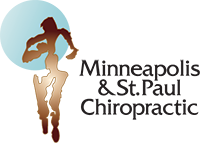
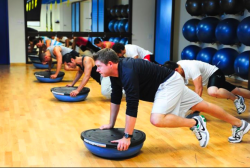










Thank you for hitting on the point that we may need to do some healing before we try to exercise pain away!